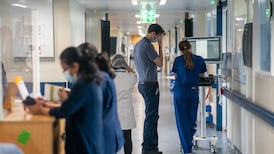At a time of rampant spread of Omicron, it is not unreasonable to ask if schools, which are due to reopen this week, are a safe environment or will they facilitate yet more Covid cases. The balance of evidence suggests they are not fuelling disease – notwithstanding uncertainties over the latest highly transmissible variant and when it will peak.
Although transmission of Covid-19 can occur in schools, research shows transmission from this source has accounted for a minority of all Covid-19 cases. This is confirmed by the latest Health Protection Surveillance Centre data published on December 22nd when Omicron was asserting itself.
Between March 1st, 2020, and December 18th, 2021, a total of 656,589 confirmed Covid-19 cases were notified. Relevant indications are: 28,796 (4.4 per cent) were pre-school children (0-4 years); 77,635 (11.8 per cent) were primary school children ( 5-12 years); 50,222 (7.6 per cent) were secondary school children (13-18 years); 499,853 (76.1 per cent) were adults (over-18s).
Hospital Report
Cases among under-18s represented 23.9 per cent of all confirmed cases.
Schools, nonetheless, reflect what’s happening in the wider community, giving rise to justifiable concerns. If appropriate control measures are implemented, it is unlikely they will play a substantial role in transmission, though outbreaks will occur.
Mixing pre-school and after school do pose significantly higher risks, according to infectious disease experts. Schools now have rigorous controls including the wearing of face masks, though there is uneven implementation of proven measures, such as deployment of ventilation; HEPA filtration devices and CO2 monitors.
The problem, however, is Covid-19 continues to be a rapidly unfolding – and complex – scenario, requiring careful balancing of risks.
With approximately a quarter of teachers at higher risk of serious consequences because of underlying medical conditions, valid concerns have been raised about occupational risk of infection for teachers and school staff.
Studies (mostly done before rollout of vaccines) on those 12 years of age and older suggest staff-to-staff transmission is more common than transmission from students to staff, staff to student, or student to student.
There are, however, record levels of Covid-19 with unprecedented numbers in isolation with restrictions impairing ability to work for a great many. The current wave may peak over the coming weeks but Omicron is so contagious it has the potential to swamp hospitals and cause many, otherwise preventable, deaths even if only a small share of infections are severe.
Moreover, it has relentless ability to hunt down the “vaccine-naive”: those with lack of immunity to fight the disease because they are unvaccinated.
Schools can operate safely without the heightened risk of Omicron spreading if guidelines are fully implemented, according to Covid specialist Dr Anne Moore of UCC School of Biochemistry. They have "the same risk as any other indoor environment; no better, no worse", she adds.
Given Omicron is so pervasive, she acknowledges the apparent contradiction in closing schools when shops and restaurants remain open. She comes down in favour of “pushing on, monitoring it and opening up [schools]”, while putting in place long-term protection measures such as improved ventilation.
The pandemic has had a substantial and long-lasting negative impact on children and young people’s physical and mental health as well as their education, but some teacher unions and parent groups insist the case can be made to close schools, or stagger the return in preference for exam classes, until the peak passes.
Given Omicron’s prevalence, Moore believes a partial return of face-to-face teaching is of little benefit, and will just make the job of principals in marshalling the return even more complicated.
Teacher unions insist doing so without introducing additional safety measures would be an "unacceptable risk". Kieran Christie, general secretary of the Association of Secondary Teachers in Ireland, points to a lack of clarity on the risk Omicron poses in school settings and whether or not mitigations in schools are sufficient and will hold up.
Based on evidence to date, Moore says Omicron is not going to be any worse in schools. If anything, spikes so far are among 19-30 year olds.
Compounding matters, however, are likely staff shortages, confusion over public health advice, while the Covid-19 testing regime is under immense strain.
Health officials on Tuesday confirmed an additional 21,302 new cases but with an overwhelmed PCR testing system and lack of routine availability of antigen tests due to the volume of the disease, the true number is probably 40 per cent higher.
Michael Gillespie, general secretary of the Teachers' Union of Ireland, said clarity was needed about the duration of self-isolation for people infected with Covid-19, so teachers and students will know if they can return to school. "A lot of members couldn't get PCR tests, but they did test positive with antigen tests, they had symptoms." That is likely to be the case with students too, where they were able to get their hands on antigen test kits.
There is one significant safety net for parents and their children. Ireland is ahead of many other countries in vaccinating secondary pupils and now moving to primary pupils over five – with no safety issues. It protects against acute disease though the extent to which it restricts transmission of Omicron is unclear. The value to parents in getting their children vaccinated is indisputable, especially as they return to a school environment.















